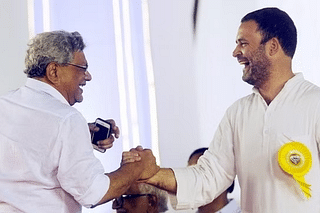Politics
Election Results Impact: Rajasthan, Chhattisgarh Expected To Go Back To NPS, But Is It That Simple?
Pratim Ranjan Bose
Dec 12, 2023, 06:00 AM | Updated 10:02 AM IST
Save & read from anywhere!
Bookmark stories for easy access on any device or the Swarajya app.

All bad things must come to an end, and so it did.
Rahul and Priyanka Gandhi’s Congress lost the assembly elections in Rajasthan and Madhya Pradesh, from where the party started challenging the fiscal stability of the country by undoing the pension reforms for government employees.
Introduced by the Bharatiya Janata Party (BJP)-led Atal Bihari Vajpayee government, the reforms were implemented across states (except in then-left-ruled West Bengal, Kerala, and Tripura) by the Congress-led Manmohan Singh government.
Rajasthan was a pioneering state in adopting the market-linked defined contribution-based pension scheme (NPS) in 2004.
In 2022, Rajasthan and Chhattisgarh became the first two states to walk backwards to the old, defined benefit pension (OPS) regime.
It will now be the task of the double-engine sarkars in Rajasthan and Chhattisgarh to correct the history and return to the path of reforms.
The Narendra Modi government at the Centre should ensure that pension reforms are cast in stone and that whichever state is still outside its ambit is forced to toe the line.
This job will, however, not be easy. And there is a high probability that the issue will be settled through a protracted legal battle.
No Easy Task
The futility of disregarding reforms, that too for barely 5-6 per cent of the population, is clear from the poll results. However, taking the pampered government employees back to market-linked reforms will surely be a political hot potato.
The Ashok Gehlot and Bhupesh Baghel governments of the Congress in Rajasthan and Chhattisgarh have created sufficient complication by offering the assured-benefit OPS to quasi-government, autonomous, and semi-autonomous bodies.
Rajasthan’s finance department issued an order earlier this year to implement OPS in boards, corporations, municipalities, and universities. Clearly, the Congress has not only created a minefield but expanded its scope and geography.
Rajasthan returned to OPS in April 2022 with a retrospective effect from 2004, when the NPS was introduced. Ideally, there is not much fiscal damage yet, as those who joined the service after 2004 should not be due for retirement this soon.
However, there is an exception to this rule. Some of the post-2004 recruits who joined the service at a relatively mature age, under compassionate grounds (like the widow of a deceased employee), are retiring. Rajasthan and Chhattisgarh may have extended the OPS benefits to them.
According to a Times of India report, in an RTI (Right to Information) response early this year, the Rajasthan government informed that nearly 900 employees who retired after 1 April 2022 have started getting pensions under the old scheme.
Then there are employees who retired with NPS benefits and have responded to the call of the government to return the money in part or in full to be eligible for the old pension scheme.
All Eyes On The Court
In short, the pension scenario in Rajasthan and Chhattisgarh is far more complicated than it was before 2004. However, there is no escape from clearing this mess, as nearly Rs 41,000 crore of employee and state contributions to NPS until 2022-23 are locked.
Finance Minister Nirmala Sitharaman already clarified that contributions to the NPS corpus were invested in long-term assets to give pensions, and there was a legal provision for such redemption.
NPS requires contributions from both employees (10 per cent) and employers (14 per cent). Participating states provided for the employees’ contribution by enhancing salaries. That is the reason salaries increased faster after the introduction of NPS.
It is also why employees are now asking for OPS. They enjoyed high salaries and now want to enjoy a high pension linked to inflation. But the pension laws put a spoke in the wheel.
The mess is deep. The Congress reintroduced OPS in three states, including Himachal Pradesh. The footsteps were followed by the Hemant Soren government in Jharkhand, where the Congress is a minority partner.
The Aam Aadmi Party (AAP) government in Punjab issued a notification for a return to OPS but did not issue subsequent guidelines. The Congress also promised OPS in Karnataka; however, the bubble burst before it was implemented.
And that, probably, will lead to a consensus among all to leave it to the court to clear the mess. The Congress governments in Himachal and Karnataka are fully aware of the scary fallouts of OPS. They may now look forward to the court to scrap it.
The BJP governments in Rajasthan and Chhattisgarh should be happy to see the court forcing them to return to NPS. And for the Modi government, it might prove to be a godsend to seal the deal in favour of pension reforms across the nation.
In the end, all it would require is a simple push. A notification from the new governments in Rajasthan and Chhatisgarh against OPS will do the trick. Employees will rush to the courts and the rest may follow the expected patterns.
If employees hit the court first, that’s even better.
Also Read:
Save & read from anywhere!
Bookmark stories for easy access on any device or the Swarajya app.
Support Swarajya's 50 Ground Reports Project & Sponsor A Story
Every general election Swarajya does a 50 ground reports project.
Aimed only at serious readers and those who appreciate the nuances of political undercurrents, the project provides a sense of India's electoral landscape. As you know, these reports are produced after considerable investment of travel, time and effort on the ground.
This time too we've kicked off the project in style and have covered over 30 constituencies already. If you're someone who appreciates such work and have enjoyed our coverage please consider sponsoring a ground report for just Rs 2999 to Rs 19,999 - it goes a long way in helping us produce more quality reportage.
You can also back this project by becoming a subscriber for as little as Rs 999 - so do click on this links and choose a plan that suits you and back us.
Click below to contribute.





